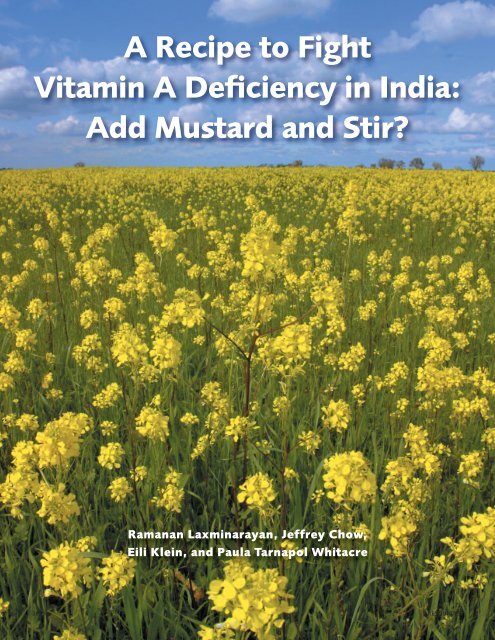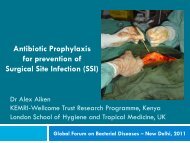A Recipe to Fight Vitamin A Deficiency in India - Center for Disease ...
A Recipe to Fight Vitamin A Deficiency in India - Center for Disease ...
A Recipe to Fight Vitamin A Deficiency in India - Center for Disease ...
- No tags were found...
You also want an ePaper? Increase the reach of your titles
YUMPU automatically turns print PDFs into web optimized ePapers that Google loves.
A <strong>Recipe</strong> <strong>to</strong> <strong>Fight</strong><strong>Vitam<strong>in</strong></strong> A <strong>Deficiency</strong> <strong>in</strong> <strong>India</strong>:Add Mustard and Stir?Ramanan Laxm<strong>in</strong>arayan, Jeffrey Chow,Eili Kle<strong>in</strong>, and Paula Tarnapol Whitacre28 RESOURCES
Have you had your vitam<strong>in</strong> A <strong>to</strong>day? Youneed it <strong>for</strong> such essential processes asgrowth, vision, and resistance <strong>to</strong> <strong>in</strong>fectiousdisease. Chances are, you don’t have much<strong>to</strong> worry about. Most adults who consumedairy products, meat, and vegetables on aregular basis are okay, as these products either conta<strong>in</strong> or are <strong>for</strong>tifiedwith vitam<strong>in</strong> A or beta-carotene, a precursor <strong>to</strong> vitam<strong>in</strong> A.But worldwide, the situation is quite different. <strong>Vitam<strong>in</strong></strong> A deficiency(VAD) is a significant cause of bl<strong>in</strong>dness and death, especially<strong>for</strong> children and pregnant and lactat<strong>in</strong>g women. Accord<strong>in</strong>g <strong>to</strong> theWorld Health Organization, an estimated 250 million preschool-agechildren <strong>in</strong> more than 100 countries are vitam<strong>in</strong> A deficient. Of these,between 250,000 <strong>to</strong> 500,000 lose their sight each year as a result, andmore than half die with<strong>in</strong> 12 months. VAD also <strong>in</strong>creases the risk ofdy<strong>in</strong>g from diseases such as malaria and measles: estimates suggestthat it contributes <strong>to</strong> the deaths of 1.2 <strong>to</strong> 3 million children annually.Approximately 7.2 million pregnant women <strong>in</strong> develop<strong>in</strong>g countriesalso suffer from VAD, which means their <strong>in</strong>fants are likely born <strong>in</strong>an already compromised state.Beyond the immediate impact on families, VAD also has a f<strong>in</strong>ancialimpact on a country. Poor nutritional status can reduce a country’sgross domestic product by 2 <strong>to</strong> 3 percent annually, accord<strong>in</strong>g<strong>to</strong> the World Bank. In addition, VAD and other nutritional deficienciescan result <strong>in</strong> significant outlays when treatment of otherwisepreventable illnesses stra<strong>in</strong>s overburdened health systems. Conversely,improv<strong>in</strong>g a person’s nutritional status can <strong>in</strong>crease his orher lifetime earn<strong>in</strong>gs by at least 10 percent, which can make a considerabledifference <strong>to</strong> a country’s economy as a whole.<strong>India</strong> has some of the highest rates of VAD <strong>in</strong> the world. Eachyear, it is associated with the deaths of 330,000 children <strong>in</strong> <strong>India</strong>alone. Although vitam<strong>in</strong> A status has improved <strong>in</strong> the past fewdecades, a survey by the National Nutrition Moni<strong>to</strong>r<strong>in</strong>g Bureau <strong>in</strong>dicatesthat 57 percent of <strong>India</strong>n children—35.4 million children—were vitam<strong>in</strong> A deficient <strong>in</strong> the late 1990s. Data also suggest thatwhile VAD affects both rural and urban households, it generally resultsfrom malnutrition.Gett<strong>in</strong>g Public Health Programs Work<strong>in</strong>gOver the past few decades, as the l<strong>in</strong>k between VAD and mortalityand morbidity have become better unders<strong>to</strong>od, countries and <strong>in</strong>ternationalorganizations have developed three ma<strong>in</strong> approaches <strong>to</strong>boost vitam<strong>in</strong> A levels: periodic supplementation of young childrenwith high dosages of vitam<strong>in</strong> A; <strong>for</strong>tification of commonly eatenfoods with vitam<strong>in</strong> A, often with other micronutrients; and otherfood-based approaches such as nutrition education and promotionof home vegetable gardens.These approaches have had results, but, as the numbers show,they have not solved the problem. Moreover, supplementation, themost commonly used <strong>in</strong>tervention, is on the decl<strong>in</strong>e, because it hasoften been implemented alongside polio immunization campaignsthat are w<strong>in</strong>d<strong>in</strong>g down <strong>in</strong> many countries.Experiences <strong>in</strong> <strong>India</strong> with these three <strong>in</strong>terventions illustrate howdifficult it is <strong>to</strong> get public health programs work<strong>in</strong>g on the ground.Although the country launched one of the world’s first supplementationprograms <strong>to</strong> fight bl<strong>in</strong>dness <strong>in</strong> 1970, only a small percentageof children now receive the recommended twice-yearly dosages ofvitam<strong>in</strong> A, and coverage varies greatly by state and by <strong>in</strong>come level.Supplementation programs <strong>in</strong> <strong>India</strong> also suffer from a lack ofsupport from <strong>India</strong>’s medical establishment—which, despite widespreadevidence—has not uni<strong>for</strong>mly endorsed vitam<strong>in</strong> A’s l<strong>in</strong>k <strong>to</strong>mortality, and has displayed a preference <strong>for</strong> <strong>for</strong>tification and foodbasedapproaches over supplementation. Un<strong>for</strong>tunately, <strong>India</strong>’shighly decentralized food-process<strong>in</strong>g systems and varied diets hamperthese other approaches, as well. Despite many <strong>in</strong>novative attemptsand pilot projects with foods that range from rice, <strong>to</strong> tea, <strong>to</strong><strong>for</strong>tified candies, less than one percent of food <strong>in</strong> <strong>India</strong> is <strong>for</strong>tifiedwith vitam<strong>in</strong> A or any other micronutrient. <strong>India</strong>’s low meat anddairy consumption <strong>in</strong>creases the likelihood that people, especiallythe poor, will get enough vitam<strong>in</strong> A from their diet alone.New advances <strong>in</strong> biotechnology have generated the possibilitythat foods genetically modified <strong>to</strong> express excess amounts of vitam<strong>in</strong>A may be an alternative. To assesses the potential of this approach,the U.S. Agency <strong>for</strong> International Development and the International<strong>Center</strong> <strong>for</strong> Tropical Agriculture asked RFF <strong>to</strong> look at onepotential option: bio<strong>for</strong>tification of mustard seed with vitam<strong>in</strong> A.(This article is based on a new RFF report, Clos<strong>in</strong>g <strong>India</strong>’s NutritionGap: The Role of Golden Mustard <strong>in</strong> <strong>Fight</strong><strong>in</strong>g <strong>Vitam<strong>in</strong></strong> A <strong>Deficiency</strong>, bythe authors. See † www.rff.org/rff/goldenmustard.)Why mustard? Cook<strong>in</strong>g oil from pressed mustard seed is commonlyused <strong>in</strong> northern <strong>India</strong> where VAD is most widely prevalent,especially among poor rural families that are often underserved bysupplementation programs. Another advantage is that vitam<strong>in</strong> A ismore easily digested when consumed with a moderate amount offat, such as edible oil. In recent years, the Monsan<strong>to</strong> Company andThe Energy and Resource Institute (TERI) <strong>in</strong> <strong>India</strong>—build<strong>in</strong>g onMonsan<strong>to</strong>’s experience bio<strong>for</strong>tifiy<strong>in</strong>g canola oil, a close genetic relative<strong>to</strong> mustard, with vitam<strong>in</strong> A—succeeded <strong>in</strong> express<strong>in</strong>g high levelsof beta-carotene <strong>in</strong> mustard seeds. The technology <strong>in</strong>volved issimilar <strong>to</strong> that used <strong>to</strong> develop the better-known “golden rice.” Oncepressed, the bio<strong>for</strong>tified mustard oil reta<strong>in</strong>s high levels of betacarotene,which is what gives the oil, like rice, its dark golden color.The <strong>for</strong>tified oil can provide far more vitam<strong>in</strong> A per serv<strong>in</strong>g thanthrough traditional means.However, after several years of labora<strong>to</strong>ry work and very limitedfield trials, ef<strong>for</strong>ts <strong>to</strong> commercialize the technology have stalled,FALL/WINTER 2008 29
despite a pledge from Monsan<strong>to</strong> <strong>to</strong> license the technology withoutcost. RFF was asked <strong>to</strong> help determ<strong>in</strong>e whether further <strong>in</strong>vestment<strong>in</strong> the technology should cont<strong>in</strong>ue. Two ma<strong>in</strong> questions were addressed:first, whether mustard production and consumption <strong>in</strong>dicateits appropriateness as a vehicle <strong>to</strong> <strong>in</strong>crease vitam<strong>in</strong> A <strong>in</strong>take; andsecond, whether bio<strong>for</strong>tification costs, particularly compared withexist<strong>in</strong>g <strong>in</strong>terventions, justify further <strong>in</strong>vestigation. If VAD-affected<strong>in</strong>dividuals do not consume mustard <strong>in</strong> sufficient quantities, especiallychildren and women, or if the costs are unreasonably high, itis not worth explor<strong>in</strong>g further.The study did not take <strong>in</strong><strong>to</strong> account the political, social, and environmentalquestions that have been central <strong>in</strong> the debate aboutgenetically modified foods worldwide, issues that policymakers cannotignore. But it provides a piece <strong>to</strong> the puzzle as new ways aresought <strong>to</strong> improve nutrition worldwide.Mustard from Mela <strong>to</strong> MouthAs with many crops <strong>in</strong> <strong>India</strong>, mustard is grown primarily on a smallscale, with most of the country’s 40 <strong>to</strong> 50 million mustard farmersplant<strong>in</strong>g about five acres annually. Production, like consumption, isconcentrated <strong>in</strong> the north. Farmers generally purchase new seedeach year, typically at melas (farm fairs), which also serve as a sourceof agricultural <strong>in</strong><strong>for</strong>mation. A number of public and private <strong>in</strong>stitutionsalso support producers and processors and are potential avenues<strong>to</strong> <strong>in</strong>troduce <strong>in</strong><strong>for</strong>mation about “golden” mustard or even distributeseed.About 90 percent of the mustard seed grown <strong>in</strong> <strong>India</strong> goes <strong>to</strong>make oil. Large manufacturers process the highest volume of oil(about 75 percent of the <strong>to</strong>tal annual production of about 2 millionmetric <strong>to</strong>ns); small-scale facilities are more <strong>in</strong>efficient, although farmore numerous. Although no reliable data exist about the extent ofhome production, anecdotally it is believed <strong>to</strong> be high.Studies on similar types of oil show it must be s<strong>to</strong>red <strong>in</strong> dark conta<strong>in</strong>ers,as vitam<strong>in</strong> A breaks down <strong>in</strong> light, and <strong>for</strong> a limited amoun<strong>to</strong>f time (n<strong>in</strong>e months <strong>in</strong> lab conditions, probably less <strong>in</strong> situationsof extreme heat or cold). There<strong>for</strong>e, the feasibility of bio<strong>for</strong>tifiedmustard as a reliable vehicle <strong>to</strong> <strong>in</strong>crease vitam<strong>in</strong> A <strong>in</strong>take depends <strong>in</strong>large part on proper packag<strong>in</strong>g and s<strong>to</strong>rage. In <strong>India</strong>, mustard oil ispurchased <strong>in</strong> small quantities from bulk suppliers or <strong>in</strong> bottles orcans as branded oil—<strong>in</strong> either case, opaque packag<strong>in</strong>g would beneeded. While it has a shelf life of up <strong>to</strong> a year, it is typically distributedfar more quickly from processor <strong>to</strong> consumer.Mustard oil is prized <strong>for</strong> its pungency and is a staple <strong>in</strong> manyhouseholds, regardless of <strong>in</strong>come, <strong>in</strong> both urban and rural areas. Althoughnot all states with VAD problems are mustard consumers(aga<strong>in</strong>, keep<strong>in</strong>g <strong>in</strong> m<strong>in</strong>d regional preferences), it is consumed <strong>in</strong> asignificant number of states where VAD is also prevalent. Assum<strong>in</strong>gthat all mustard oil was bio<strong>for</strong>tified and none of the vitam<strong>in</strong> A waslost dur<strong>in</strong>g s<strong>to</strong>rage or cook<strong>in</strong>g—admittedly very optimistic assumptions—achild would need less than one teaspoon a day <strong>to</strong> gettheir recommended daily allowance, assum<strong>in</strong>g no other source ofthe vitam<strong>in</strong> was available.Consumption among the poor is closely tied <strong>to</strong> household productionof mustard oil, especially <strong>in</strong> rural areas. Households withno cash <strong>in</strong>come still consume small amounts, which suggests theneed <strong>to</strong> get bio<strong>for</strong>tified seed <strong>to</strong> home-based producers. On the otherhand, some states with a high prevalence of VAD consume mustardoil shipped <strong>in</strong> from other states, most likely from one of the fewlarge processors. In other words, both large commercial producersand small producers would need <strong>to</strong> buy or grow bio<strong>for</strong>tified seed <strong>in</strong>order <strong>to</strong> reach all the people suffer<strong>in</strong>g from VAD.Is It Worth It?An economic-based analysis of bio<strong>for</strong>tified mustard <strong>to</strong> fight VADdoes not provide the whole answer. However, the RFF analysis createsa framework aga<strong>in</strong>st which <strong>to</strong> explore other issues. If bio<strong>for</strong>tifiedThe ancient Egyptians and Greeks were on <strong>to</strong> someth<strong>in</strong>gwhen they treated ocular problems with a piece of liver consumedor placed on <strong>to</strong>p of the eyes. Centuries later, doc<strong>to</strong>rsrecognized that meat and milk could cure night bl<strong>in</strong>dness, asymp<strong>to</strong>m of vitam<strong>in</strong> A deficiency (VAD). By the early part of20th century, the role that vitam<strong>in</strong>s and other nutrients play<strong>in</strong> human health was firmly established, and VAD was generallyelim<strong>in</strong>ated from developed nations.<strong>Vitam<strong>in</strong></strong> A is consumed as ret<strong>in</strong>ol <strong>in</strong> animal foods, such asmeat, dairy products, and eggs, or as carotenoids (pr<strong>in</strong>cipallybeta-carotene) <strong>in</strong> many fruits and vegetables, such asdark green leafy vegetables, mangoes, and squash. Becausethe body absorbs ret<strong>in</strong>ol far more efficiently than carotenoids,adequate vitam<strong>in</strong> A <strong>in</strong>take requires more “ret<strong>in</strong>olactivity equivalents“ from vegetable sources than from animalproducts—<strong>in</strong> other words, far larger amounts of fruitsand vegetables must be consumed <strong>to</strong> reach the recommendeddaily allowance <strong>for</strong> vitam<strong>in</strong> A. Absorption of vitam<strong>in</strong>A also depends on a person’s fat <strong>in</strong>take (because it is afat-soluble vitam<strong>in</strong>, more fat is better <strong>in</strong> this <strong>in</strong>stance), howthe food is prepared and s<strong>to</strong>red, and the presence or absenceof parasites <strong>in</strong> the body.The bot<strong>to</strong>m l<strong>in</strong>e is that a person, especially a child, cannotrealistically get sufficient vitam<strong>in</strong> A from diet alone if heor she consumes little or no animal products, even with lotsof beta-carotene rich foods.30 RESOURCES
mustard can’t meet the vitam<strong>in</strong> A needs of vulnerable populations—or would do so at a cost that makes it unfeasible on a wide enoughbasis <strong>to</strong> solve anyth<strong>in</strong>g—then these other questions become moot.The cost-effectiveness analysis compared supplementation, traditional<strong>for</strong>tification of processed mustard oil, and bio<strong>for</strong>tification ofmustard seed. The economic burden of avoid<strong>in</strong>g diseases was calculatedus<strong>in</strong>g disability-adjusted life years (DALYS), which is an adjustedmeasure of years lost due <strong>to</strong> premature death or disability,where different <strong>for</strong>ms of disability are given different weights. Thecomparison is based on the cost per DALY averted (cost-effectivenessratio) <strong>for</strong> each of the three <strong>in</strong>terventions over a 20-year time frame.Costs <strong>for</strong> supplementation <strong>in</strong>clude those associated with dos<strong>in</strong>gchildren twice annually through exist<strong>in</strong>g health centers; tra<strong>in</strong><strong>in</strong>g,promotion, and moni<strong>to</strong>r<strong>in</strong>g; and an additional amount <strong>to</strong> reach areaswithout function<strong>in</strong>g health centers. Costs of traditional <strong>for</strong>tification<strong>in</strong>clude processes <strong>to</strong> ensure product quality and <strong>to</strong> promoteconsumption, as well as <strong>to</strong> <strong>for</strong>tify the oil with beta-carotene. Bio<strong>for</strong>tificationcosts <strong>in</strong>clude the same quality-related costs, as well asa one-time cost <strong>to</strong> account <strong>for</strong> research and development and licens<strong>in</strong>gof the seed (estimated at $5.6 million). Additional seed costs<strong>for</strong> farmers were not fac<strong>to</strong>red <strong>in</strong>, nor were potential costs related <strong>to</strong>uncerta<strong>in</strong> environmental impacts of genetically modified crops.The RFF analysis shows that the most cost-effective <strong>in</strong>terventionrema<strong>in</strong>s supplementation, followed by bio<strong>for</strong>tification and traditional<strong>for</strong>tification. Despite less favorable economic numbers, bio<strong>for</strong>tifiedmustard has the potential <strong>to</strong> avert a greater burden of childhoodand maternal death than both traditional <strong>for</strong>tification andsupplementation, particularly <strong>in</strong> areas with weak coverage by thehealth care system.No matter the analysis, mustard farmers must be will<strong>in</strong>g <strong>to</strong> plantthe bio<strong>for</strong>tified varieties, and consumers must be will<strong>in</strong>g <strong>to</strong> consumesufficient quantities of it. As traditional <strong>for</strong>tification ef<strong>for</strong>ts show,both a “push” strategy <strong>to</strong> <strong>in</strong>crease the attractiveness <strong>to</strong> growers andoil producers and a “pull” strategy <strong>to</strong> <strong>in</strong>crease consumer demand <strong>for</strong><strong>for</strong>tified oil would be needed. These challenges are not novel <strong>to</strong> bio<strong>for</strong>tification,but their successful resolution rema<strong>in</strong>s unknown.Experience shows that <strong>India</strong>n farmers are will<strong>in</strong>g <strong>to</strong> adopt newtechnologies when they recognize tangible benefits, such as improvedyield, higher revenues, lower price of <strong>in</strong>puts, or some comb<strong>in</strong>ation.The RFF study looked at several strategies <strong>to</strong> provide <strong>in</strong>centives,from a full-scale plan <strong>to</strong> subsidize costs at all levels ofproduction <strong>to</strong> a market-based approach that would target seed productionalone. The latter is less resource-<strong>in</strong>tensive and would probablyyield comparable results. A program could offer free seeds ortargeted seed subsidies, especially <strong>in</strong> areas where production andconsumption are high so that demand could also be stimulated.While all seed would not have <strong>to</strong> be bio<strong>for</strong>tified <strong>to</strong> accrue nutritionalbenefits, a significantly high amount would.The challenge <strong>for</strong> bio<strong>for</strong>tified mustard oil, as <strong>for</strong> other health© DAVID ZIMMERLYpractices that do not result <strong>in</strong> immediate, visible benefits, is <strong>to</strong> educateconsumers <strong>to</strong> want <strong>to</strong> use the enhanced product. Given somewell-publicized cases with food adulteration <strong>in</strong> <strong>India</strong>, a campaign <strong>to</strong>reliably identify the enhanced product would be needed, re<strong>in</strong><strong>for</strong>cedby public health messages from credible sources such as the medicalestablishment and nonprofit organizations.In short, a wide-scale attempt <strong>to</strong> <strong>in</strong>troduce bio<strong>for</strong>tified mustardwould have <strong>to</strong> overcome hurdles <strong>to</strong> technology adoption by growersand ga<strong>in</strong> acceptance by consumers <strong>to</strong> ensure that the projectedbenefits are achieved. The challenge is no less daunt<strong>in</strong>g than otherhealth campaigns, <strong>in</strong>clud<strong>in</strong>g other methods of <strong>in</strong>creas<strong>in</strong>g vitam<strong>in</strong> A<strong>in</strong>take, but would have <strong>to</strong> be considered and planned <strong>for</strong>.Wider ImplicationsA bio<strong>for</strong>tification strategy can play an important role as part of abroader approach <strong>to</strong> reduc<strong>in</strong>g the prevalence of VAD <strong>in</strong> <strong>India</strong>. Suchstrategies can be cost-effective, feasible, and implemented underconditions where supplementation and <strong>for</strong>tification are currentlydisadvantaged. However, there are significant barriers. Perhaps <strong>for</strong>emos<strong>to</strong>f these is that recognition of the importance of VAD as a publichealth problem <strong>in</strong> <strong>India</strong> is low. Without this recognition, all strategies<strong>to</strong> address VAD are doomed. Even with it, supporters wouldhave <strong>to</strong> overcome many operational challenges. Additional concernsspecific <strong>to</strong> biotechnology also cannot be ignored, as they rema<strong>in</strong> acont<strong>in</strong>u<strong>in</strong>g barrier <strong>to</strong> adoption of mustard or any other geneticallymodified foods.So, <strong>to</strong> bio<strong>for</strong>tify or not <strong>to</strong> bio<strong>for</strong>tify? Golden mustard is not theproverbial silver bullet <strong>to</strong> solve vitam<strong>in</strong> A or other micronutrientdeficiencies. Yet, with evidence that millions of children and women<strong>in</strong> <strong>India</strong> and worldwide can benefit from even modest <strong>in</strong>creases <strong>in</strong>consumption of the vitam<strong>in</strong>, it deserves a closer look.∫FALL/WINTER 2008 31
















